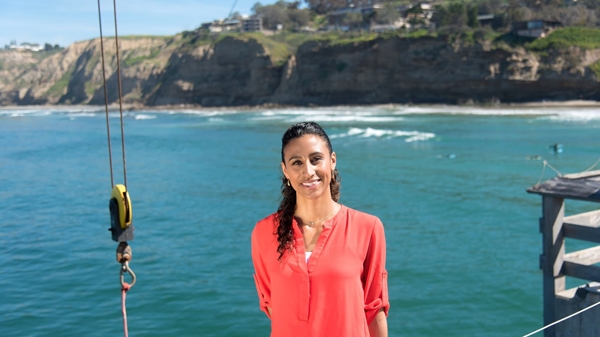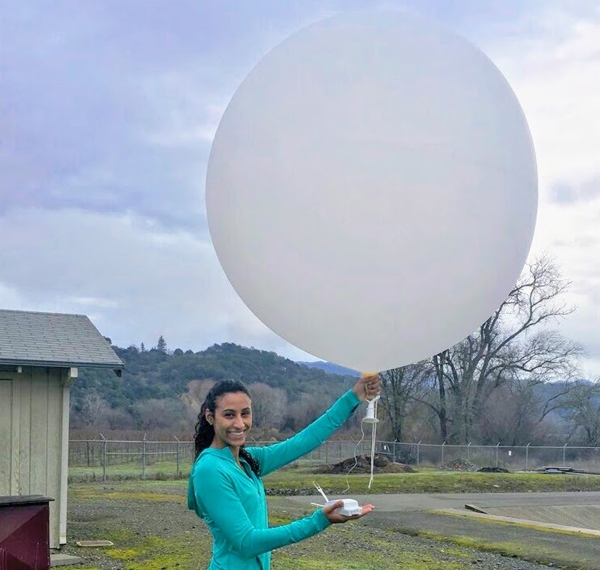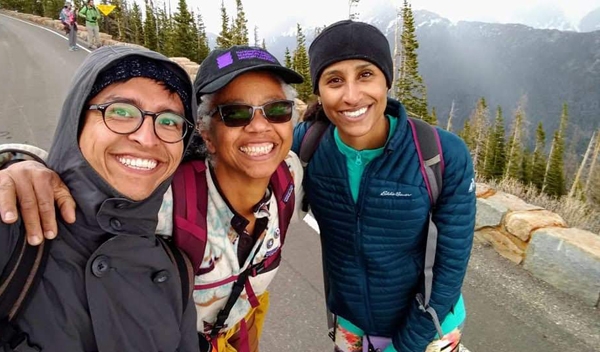
Tashiana Osborne is a PhD student with the Scripps Institution for Oceanography at UC San Diego where she works within the Center for Western Weather and Water Extremes on atmospheric river research.
As a graduate student, you already have an incredible amount of experience, including working as a storm chaser and intern at NASA. Can you tell us a little more about your current research?
I investigate extreme rain and snow events that affect the western U.S., where many extreme weather events are tied to atmospheric rivers. Atmospheric rivers are like rivers in the sky. They are long, narrow bands of enhanced water vapor traveling in the lower atmosphere.
When atmospheric rivers reach land, they can have widespread impacts. While the precipitation they produce provides water for residential and agricultural use, they can also lead to destructive flood or snow events. At the other end of the spectrum, a long absence of atmospheric rivers can lead to prolonged droughts. Overall, there are implications for public safety, water and food security, and the economy, including costly droughts, wildfires, snow events, floods, and mudslides.
Currently, I'm exploring using radar data to investigate the behavior of the atmospheric snow level, where falling snow melts to rain. Especially in higher-elevation regions like the Sierra Nevada, the snow level is key in determining whether a basin receives rain or snow, which then determines the impact of the event. For example, snow accumulates and contributes to water supply gradually, though heavy snow may lead to power outages, traffic delays, and even avalanches. Rain, on the other hand, flows into rivers and reservoirs more quickly, and can rapidly contribute to flooding events. It is crucial, therefore, that we understand how the snow level fluctuates to prepare for impacts of precipitation events.
You've said that it's important to you to work to empower younger students, and share the possibilities of STEM with disadvantaged and marginalized communities. How are you working on these issues?
Although we faced struggles at times, my brother and I were fortunate to be exposed to nature thanks to some of our quirky, nature-loving family members. Yes, nature is chaotic, but it can also provide an escape; a way to connect with something bigger than myself through some of life's most challenging times. I want others to have access to these bigger experiences too.
As a Voices for Science Advocate through the American Geophysical Union, I've committed to activate in science outreach, communication, and policy. As Advocates, we unofficially call ourselves the Science Avengers, taking action to empower others to “show their cape”!
It's also important to acknowledge that higher education programs, especially in STEM, can present additional challenges for students from underrepresented groups. We've seen that diverse perspectives contribute to better science, and that diversity initiatives without inclusion are not enough. In my eyes, investing in youth and amplifying community voices often left out of political conversations can directly help strengthen the nation and world.
For the past four years, I've served as a science mentor for the Preuss School's Girls in STEAM (Science, Technology, Engineering, Arts, and Mathematics) Conference, encouraging girls who strive to become the first in their families to graduate from college. For the past two years, I've volunteered during the Garibaldi Bowl, an ocean sciences competition for San Diego high school students. I've also been fortunate to interact with students by sharing my experiences during panels and visiting classrooms.
I recently returned to Colorado as a Rocky Mountain Science and Sustainability Network Summer Academy alumna. The Academy aims to develop a diverse population of undergraduate students ready to collaborate on issues relating to sustainability and community engagement in the protection of natural resources. For some students, visiting a U.S. national park as part of the program was a first.
Finally, I strive to reach politically-minded groups through science policy efforts and training. For example, I've had the honor of serving as a Scripps delegate for United Nations Climate Change Conferences. At the conferences, I share with and learn from a global crowd comprised of government representatives, journalists, and others. I've learned that research has the power to inform effective and responsible policy decisions to help us become better protected and prepared in our changing climate, which affects us right here in California.
What do you find most exciting or challenging about your research?
There are many things that add excitement! Not to mention many others that create challenges from which to grow. As one example, from December through March, I sometimes do field work in northern California. I sign up for a couple weeks where I'm essentially “on-call.” This means, if forecasts suggest there will be an atmospheric river, I might suddenly be contacted to pack up and book a flight.
During field work, we work together to launch weather balloons every three hours to measure atmospheric variables at different altitudes in the atmosphere – yes, even overnight and in rain and wind! Field experiences like this, and other interactions and collaborations with fellow scientists from various backgrounds, rev-up my excitement for science, and make me feel part of a mission.
In science, one of the big challenges is constructing and investigating questions that have complex, unexplored answers. We push limits and learn new skills while applying what we've stored in our knowledge toolbox. We also find ways to creatively represent and communicate results. In doing so, we may realize our efforts make up just one piece of the larger puzzle. This can be disconcerting, but also motivating because we care a lot about the world around us.
My long-term goal is to explore questions that directly address problems society faces, and share findings in ways that help contribute to solutions. That way, there's a chance those individual puzzle pieces can fit into broader efforts focused on protecting people and ecosystems and, optimistically, improving the world we live in.
You can find Tashiana on Twitter @TashianaOsborne and the Center for Western Weather and Water Extremes @CW3E_Scripps.


